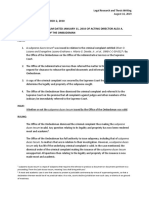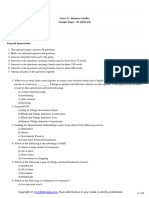0 ratings0% found this document useful (0 votes)
37 viewsGHS Hazard Classification. GHS Uses Three Hazard Classes: Health Hazards, Physical Hazards
GHS Hazard Classification. GHS Uses Three Hazard Classes: Health Hazards, Physical Hazards
Uploaded by
Irvan Pranatha SijabatGHS is an acronym for the Globally Harmonized System of Classification and Labelling of Chemicals. It aims to standardize hazard classification and communication by defining chemical hazards and implementing consistent labelling systems worldwide. The GHS system was developed by international experts to enhance the protection of human health and the environment from chemical risks.
Copyright:
© All Rights Reserved
Available Formats
Download as DOCX, PDF, TXT or read online from Scribd
GHS Hazard Classification. GHS Uses Three Hazard Classes: Health Hazards, Physical Hazards
GHS Hazard Classification. GHS Uses Three Hazard Classes: Health Hazards, Physical Hazards
Uploaded by
Irvan Pranatha Sijabat0 ratings0% found this document useful (0 votes)
37 views1 pageGHS is an acronym for the Globally Harmonized System of Classification and Labelling of Chemicals. It aims to standardize hazard classification and communication by defining chemical hazards and implementing consistent labelling systems worldwide. The GHS system was developed by international experts to enhance the protection of human health and the environment from chemical risks.
Original Title
Ghs
Copyright
© © All Rights Reserved
Available Formats
DOCX, PDF, TXT or read online from Scribd
Share this document
Did you find this document useful?
Is this content inappropriate?
GHS is an acronym for the Globally Harmonized System of Classification and Labelling of Chemicals. It aims to standardize hazard classification and communication by defining chemical hazards and implementing consistent labelling systems worldwide. The GHS system was developed by international experts to enhance the protection of human health and the environment from chemical risks.
Copyright:
© All Rights Reserved
Available Formats
Download as DOCX, PDF, TXT or read online from Scribd
Download as docx, pdf, or txt
0 ratings0% found this document useful (0 votes)
37 views1 pageGHS Hazard Classification. GHS Uses Three Hazard Classes: Health Hazards, Physical Hazards
GHS Hazard Classification. GHS Uses Three Hazard Classes: Health Hazards, Physical Hazards
Uploaded by
Irvan Pranatha SijabatGHS is an acronym for the Globally Harmonized System of Classification and Labelling of Chemicals. It aims to standardize hazard classification and communication by defining chemical hazards and implementing consistent labelling systems worldwide. The GHS system was developed by international experts to enhance the protection of human health and the environment from chemical risks.
Copyright:
© All Rights Reserved
Available Formats
Download as DOCX, PDF, TXT or read online from Scribd
Download as docx, pdf, or txt
You are on page 1of 1
GHS adalah singkatan dari Sistem Klasifikasi dan Pelabelan Bahan Kimia yang Harmonis
Globalisasi. GHS mendefinisikan dan mengklasifikasikan bahaya produk kimia, dan
mengkomunikasikan informasi kesehatan dan keselamatan pada label dan lembar data
keselamatan). Tujuannya adalah agar seperangkat aturan yang sama untuk mengklasifikasikan
bahaya, dan format serta konten yang sama untuk label dan lembar data keselamatan (SDS)
akan diadopsi dan digunakan di seluruh dunia. Tim internasional pakar komunikasi bahaya
mengembangkan GHS.
What is the purpose of GHS?
GHS, to provide harmonized information to users of chemicals with the goal of enhancing
protection of human health and the environment. Many countries already have regulatory
systems in place for chemical classification and hazard communication.
The GHS is a system for standardizing and harmonizing the classification and. labeling of
chemicals. It is a logical and comprehensive approach to: • Defining health, physical and
environmental hazards of chemicals; • Creating classification processes that use available data
on chemicals for comparison.
Why is it important to have a global system for Labelling chemicals?
GHS also provides the basis for harmonising regulations on chemicals at national, regional and
worldwide level. This is important for facilitating trade. At a more basic level, GHS also aims to
provide a structure for countries that do not yet have a classification and labelling system
Is GHS mandatory?
The GHS is not a global law or regulation– a common misconception – it is a system. Think of it
as a set of recommendations or collection of best practices. No country is obligated to adopt all
or even any part of the GHS
What does GHS pictogram mean?
This pictogram on a chemical label means that the substance causes skin burns, eye damage,
or destroys metals.
What are the GHS categories?
GHS Hazard Classification. GHS uses three hazard classes: Health Hazards, Physical Hazards
and Environmental Hazards. These aren't required by OSHA. Health hazards present dangers
to human health (i.e. breathing or vision) while physical hazards cause damage to the body (like
skin corrosion)
How many GHS symbols are there?
There are a total of nine different pictograms, each representing a different type of hazard.
There are 9 hazardous substances symbols you need to know: flammable/api,
oxidizing/pengoksidasi/flame over circle, explosives/bom peledak, gas under pressure/gas
cylinder, toxic/akut/tengokrak/tulang bersilang, serious health hazard, health hazard/tanda
seru, corrosive/korosi/iritasi kulit and environmental hazard/bahaya bagi lingkungan. Read
more about them and examples of each here.
You might also like
- Hotel Lease AgreementDocument4 pagesHotel Lease AgreementDavid Brito25% (4)
- (D) Re Subpoena Duces Tecum AM No 10 1 13 SCDocument1 page(D) Re Subpoena Duces Tecum AM No 10 1 13 SCJen75% (4)
- Dhruv Rajput NewDocument13 pagesDhruv Rajput NewAbhay SharmaNo ratings yet
- ACCCOB2 Chapter 3 RECEIVABLES PROBLEM SOLVINGDocument15 pagesACCCOB2 Chapter 3 RECEIVABLES PROBLEM SOLVINGAyanna CameroNo ratings yet
- NPCA GHS OverviewDocument40 pagesNPCA GHS OverviewJatin TakkarNo ratings yet
- The Globally Harmonized System (GHS) For Hazard Classification and LabellingDocument36 pagesThe Globally Harmonized System (GHS) For Hazard Classification and Labellingrazy896100% (3)
- Hazard CommunicationDocument11 pagesHazard Communicationcontactjiya2No ratings yet
- The Globally Harmonized System of Classification & Labeling of ChemicalsDocument5 pagesThe Globally Harmonized System of Classification & Labeling of Chemicalsjohn sinnyNo ratings yet
- The Ultimate GHS Hazard Classification Guide - ERA Software SolutionsDocument32 pagesThe Ultimate GHS Hazard Classification Guide - ERA Software SolutionsDina AzizNo ratings yet
- Unit 2BDocument5 pagesUnit 2BNella NellaNo ratings yet
- Chapter 2Document22 pagesChapter 2Cybrille Fleur Siobhan QúeensNo ratings yet
- GHS Booklet PDFDocument42 pagesGHS Booklet PDFanon_190510257No ratings yet
- Ghshazcom 3 RDQTRDocument60 pagesGhshazcom 3 RDQTRmirzasaeed314No ratings yet
- 7 Fasey GHS QuickoverviewDocument28 pages7 Fasey GHS QuickoverviewvengielNo ratings yet
- Finding Hazard Information Lecture 6 15102024 091735amDocument12 pagesFinding Hazard Information Lecture 6 15102024 091735ammh2117928No ratings yet
- Hazard Communication and Chemical Safety: By: Francis Ivan BarcelonaDocument11 pagesHazard Communication and Chemical Safety: By: Francis Ivan BarcelonaAko C. IvanNo ratings yet
- HazCom GuideDocument23 pagesHazCom GuideAZHAR AHAMEDNo ratings yet
- Globally Harmonised System of Classification and Labelling of ChemicalsDocument2 pagesGlobally Harmonised System of Classification and Labelling of ChemicalsDomenic Di BiasiNo ratings yet
- 2.classification and Labelling Systems For ChemicalsDocument6 pages2.classification and Labelling Systems For Chemicalsjacobpm2010100% (1)
- Osha 1926 Construction Manual: Checklist For ComplianceDocument51 pagesOsha 1926 Construction Manual: Checklist For Compliancemutia fajriahNo ratings yet
- 1 Hazardous Chemicals & MSDSDocument11 pages1 Hazardous Chemicals & MSDSMazrul Ramzi MokhtarNo ratings yet
- HAZCOM and GHS - Chemical HazardsDocument42 pagesHAZCOM and GHS - Chemical HazardsAwalludin Pandu NegaraNo ratings yet
- Hazard Classification of Household Chemical Products in Korea According To The Globally Harmonized System of Classification and Labeling of ChemicalsDocument11 pagesHazard Classification of Household Chemical Products in Korea According To The Globally Harmonized System of Classification and Labeling of Chemicalsjapra17No ratings yet
- New HazCom Training DraftDocument14 pagesNew HazCom Training DraftMariajosé Cabrera MuñozNo ratings yet
- Cop Managing Risks Hazardous ChemicalsDocument92 pagesCop Managing Risks Hazardous ChemicalsMehran AliNo ratings yet
- Understanding A Safety Data Sheet (SDS) in Regards To Process SafetyDocument11 pagesUnderstanding A Safety Data Sheet (SDS) in Regards To Process SafetyIkechukwu Stanley OkoroNo ratings yet
- 3 UNEP ChemControlGuideDocument52 pages3 UNEP ChemControlGuideHance BaetaNo ratings yet
- GHS StandardDocument2 pagesGHS StandardMIchigan1111No ratings yet
- Rift Valley Technical Training InstituteDocument8 pagesRift Valley Technical Training Instituteedith kuruiNo ratings yet
- Group8 TranscriptDocument12 pagesGroup8 Transcriptenojo maria theresaNo ratings yet
- Practical 4 L01-P1 Group 1Document4 pagesPractical 4 L01-P1 Group 1Daniel IsmailNo ratings yet
- Ghs OPP Safety Hazard Criteria-SummaryDocument22 pagesGhs OPP Safety Hazard Criteria-SummaryShalu John CNo ratings yet
- 12 Joint Dti Denr Da Dof Doh Dilg Dole DotcDocument4 pages12 Joint Dti Denr Da Dof Doh Dilg Dole DotcJosh JeremaiahNo ratings yet
- Fy13 Sh-24928-13 Section 1 - HAZCOM GHS Overview PresentationDocument126 pagesFy13 Sh-24928-13 Section 1 - HAZCOM GHS Overview PresentationbenonNo ratings yet
- GHS & Safety: Ready For The Start With Merck ChemicalsDocument8 pagesGHS & Safety: Ready For The Start With Merck ChemicalsRodolfo Carmona SierraNo ratings yet
- What Is Hazard CommunicationDocument3 pagesWhat Is Hazard CommunicationdanerdrrellNo ratings yet
- Essay Health and SafetyDocument6 pagesEssay Health and SafetyGagan Cheema VirkNo ratings yet
- What Is COSHH? Questions About COSHH Answered: January 8, 2013 byDocument2 pagesWhat Is COSHH? Questions About COSHH Answered: January 8, 2013 byRrichard Prieto MmallariNo ratings yet
- Bu Ning Ahli k3k Mei 22 - Overview-OkDocument34 pagesBu Ning Ahli k3k Mei 22 - Overview-OkArista DianaNo ratings yet
- HCS2012 GHS MainDocument75 pagesHCS2012 GHS MainJananiNo ratings yet
- QuickLabel GHS Labeling White PaperDocument15 pagesQuickLabel GHS Labeling White Papermyxomatosis33No ratings yet
- Chemical ClassificatonDocument10 pagesChemical Classificatontouhidi1991No ratings yet
- Chapter 9 Risk ManagementDocument63 pagesChapter 9 Risk ManagementNiño Michael PagcaliwaganNo ratings yet
- Guidance On Key Considerations For The Identifi Cation and Selection of Safer Chemical AlternativesDocument55 pagesGuidance On Key Considerations For The Identifi Cation and Selection of Safer Chemical AlternativesCHRISTOS KALOUDISNo ratings yet
- Asdf Asdfa Sdfas DDocument3 pagesAsdf Asdfa Sdfas DKeaton EisenmengerNo ratings yet
- International Council On Harmonisation (ICH) International Council On Harmonisation of Technical Requirements For Registration of Pharmaceuticals For Human UseDocument6 pagesInternational Council On Harmonisation (ICH) International Council On Harmonisation of Technical Requirements For Registration of Pharmaceuticals For Human Usesandeep singh gaurNo ratings yet
- TBT Coshh2Document5 pagesTBT Coshh2Saurabh SharmaNo ratings yet
- Guide To Worker Safety and Health in The Marijuana IndustryDocument78 pagesGuide To Worker Safety and Health in The Marijuana IndustryMichael_Lee_Roberts100% (3)
- Material Safety Data Sheets (MSDS)Document27 pagesMaterial Safety Data Sheets (MSDS)ahmet yasin karlıkNo ratings yet
- Dental Materials AsssignmentDocument3 pagesDental Materials Asssignmentapi-736239240No ratings yet
- International Conference On Harmonization of TechnDocument3 pagesInternational Conference On Harmonization of TechnCarolina serranoNo ratings yet
- Control Banding B NaumannDocument11 pagesControl Banding B NaumannipliprensNo ratings yet
- Hazardous Substances RJC Guidance Draftv1Document6 pagesHazardous Substances RJC Guidance Draftv1Chaitanya NarreddyNo ratings yet
- GHS Presentation 1Document33 pagesGHS Presentation 1Gustavo adolfoNo ratings yet
- 2 - Regulations - Comparison of Hazard Communication RequirementsDocument25 pages2 - Regulations - Comparison of Hazard Communication RequirementsAbdul BasitNo ratings yet
- 1 - Chemicals in The WorkplaceDocument58 pages1 - Chemicals in The WorkplaceDLPS HSENo ratings yet
- MSDS - Safety Data SheetDocument54 pagesMSDS - Safety Data SheetRamesh KumarNo ratings yet
- COSHH: Control of Substances Hazardous To HealthDocument4 pagesCOSHH: Control of Substances Hazardous To HealthmahyarbNo ratings yet
- The WHO Recommended Classifi Cation of Pesticides by HazardDocument100 pagesThe WHO Recommended Classifi Cation of Pesticides by HazardKata SzűcsNo ratings yet
- International Code of Conduct on Pesticide Management: Guidelines on Good Labelling Practice for Pesticides (Revised) August 2015From EverandInternational Code of Conduct on Pesticide Management: Guidelines on Good Labelling Practice for Pesticides (Revised) August 2015No ratings yet
- Contract Research and Development Organizations-Their History, Selection, and UtilizationFrom EverandContract Research and Development Organizations-Their History, Selection, and UtilizationNo ratings yet
- Compatibility of Pharmaceutical Solutions and Contact Materials: Safety Assessments of Extractables and Leachables for Pharmaceutical ProductsFrom EverandCompatibility of Pharmaceutical Solutions and Contact Materials: Safety Assessments of Extractables and Leachables for Pharmaceutical ProductsNo ratings yet
- FSMA and Food Safety Systems: Understanding and Implementing the RulesFrom EverandFSMA and Food Safety Systems: Understanding and Implementing the RulesNo ratings yet
- Predictable Question of Bleaching'Document2 pagesPredictable Question of Bleaching'Irvan Pranatha SijabatNo ratings yet
- Question 1 Through 10 Are Based On The Following PassageDocument3 pagesQuestion 1 Through 10 Are Based On The Following PassageIrvan Pranatha Sijabat100% (1)
- Grafik RFCDocument2 pagesGrafik RFCIrvan Pranatha SijabatNo ratings yet
- KomputDocument1 pageKomputIrvan Pranatha SijabatNo ratings yet
- Fenomena Perpindahan Kelas C Tahun Ajaran 2016/2017Document1 pageFenomena Perpindahan Kelas C Tahun Ajaran 2016/2017Irvan Pranatha SijabatNo ratings yet
- 11 Business Studies23 24sp01Document12 pages11 Business Studies23 24sp01Tech with Tesu100% (1)
- AP Euro Machiavelli ErasmusDocument4 pagesAP Euro Machiavelli ErasmusEliana Josephine Gemelos-HernandezNo ratings yet
- CUZL232 Law of Tort IIDocument51 pagesCUZL232 Law of Tort IIPenelope NgomaNo ratings yet
- Mohandas Karamchand GandhiDocument57 pagesMohandas Karamchand GandhiAnurag BhargavaNo ratings yet
- Situation Reaction Test: Follow Us On Telegram SSB FUTURE OFFICERS @ssbgeneraldiscussionDocument4 pagesSituation Reaction Test: Follow Us On Telegram SSB FUTURE OFFICERS @ssbgeneraldiscussionAkanksha GuptaNo ratings yet
- Sius TF 122 12Document1 pageSius TF 122 12Anonymous iMVRREYNo ratings yet
- Labo Jr. vs. COMELEC and LardizabalDocument2 pagesLabo Jr. vs. COMELEC and LardizabalRobinson MojicaNo ratings yet
- IM5 CALCULUS-ModuleDocument17 pagesIM5 CALCULUS-ModuleDarryl Kane CulambotNo ratings yet
- Understanding Copyright and Related Rights (Wipo - Pub - 909)Document24 pagesUnderstanding Copyright and Related Rights (Wipo - Pub - 909)anna_blonde16No ratings yet
- RPLI FormDocument7 pagesRPLI FormAngrez SinghNo ratings yet
- Rameshkspj@GmailDocument1 pageRameshkspj@GmailRamesh KumarNo ratings yet
- DCBDocument10 pagesDCBsaurs2100% (1)
- Life InsuranceDocument7 pagesLife Insurancerupesh_kanabar1604100% (8)
- Practice EssayDocument6 pagesPractice Essaytbanhire2006No ratings yet
- Undrained Triaxial Test On Saturated Sands-Bishop & Eldin 1950Document20 pagesUndrained Triaxial Test On Saturated Sands-Bishop & Eldin 1950Anonymous GnfGTwNo ratings yet
- Project Report For Bank Loan - Format, Details - AKT AssociatesDocument13 pagesProject Report For Bank Loan - Format, Details - AKT AssociatesCatch a starNo ratings yet
- 2010 Cross BikesDocument541 pages2010 Cross BikesRon RobichaudNo ratings yet
- Labor - G.R. No. 220898 - DigestDocument2 pagesLabor - G.R. No. 220898 - Digestjireh bacsNo ratings yet
- Publicatie Investing in BangladeshDocument80 pagesPublicatie Investing in BangladeshShouravpedia™No ratings yet
- Columbus Bank & Trust vs. Michael A. Eddings Lawsuit: Docket, Notice of Removal, Complaint, Exhibit ADocument110 pagesColumbus Bank & Trust vs. Michael A. Eddings Lawsuit: Docket, Notice of Removal, Complaint, Exhibit AColumbus GA WhispersNo ratings yet
- Configuring Windows 8Document617 pagesConfiguring Windows 8PazNo ratings yet
- Difference Between Kidnapping and AbductionDocument8 pagesDifference Between Kidnapping and AbductionJayesh RajputNo ratings yet
- NotesDocument7 pagesNotesManilyn TabiananNo ratings yet
- Bassam AbdulwahabDocument14 pagesBassam Abdulwahabalaatrans1No ratings yet
- Individual Income Tax NOTESDocument1 pageIndividual Income Tax NOTESNavsNo ratings yet
- Hindu Hindutva and Hinduism PDFDocument4 pagesHindu Hindutva and Hinduism PDFSanity FairNo ratings yet






























































































